Recent Articles
Popular Makes
Body Types
2007 Ford Explorer Sport Trac First Drive
Ford looks to gain traction with this sporty Explorer derivative
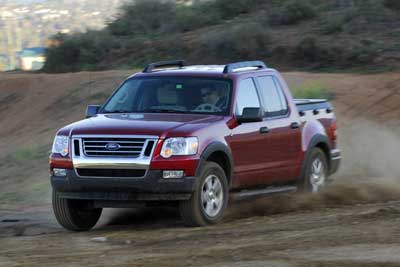
SAN DIEGO – To thrive in modern society, one must understand and embrace the art of multi-tasking. The days of Dad going off to work while Mom stays home with the kids are largely gone, as are focused job descriptions and check books. Instead, dual-income households are home to Dad pinch-hitting for daycare drop-off duty as Mom conducts a conference call on her way to the airport, all while their colleagues are at the office simultaneously paying bills online and checking the day’s email. People are becoming akin to Swiss Army knives, and their vehicles are being forced to keep pace. Many car shoppers now demand that a truck do more than haul cargo, an SUV tote an upright refrigerator, and a sedan serve as more than a commuter car. Such buyers are afforded few choices, with three notable exceptions: the Chevrolet Avalanche, the Honda Ridgeline and the Ford Explorer Sport Trac. Redesigned for 2007, the Sport Trac rides on the 2006 Explorer’s platform, shares much of the design forward of the C-pillar, and draws power from the familiar 4.0-liter V6 or a 292-horsepower 4.6-liter V8. The interior has also been borrowed from the Explorer, and an independent rear suspension system makes room for a deeper and wider cargo box, one with storage holds similar to those found on the Ridgeline. Which brings back the issue of this vehicle’s primary competitor, that Honda with its multi-jointed tailgate, deep cargo well, and that contentious rear pillar design. Despite being the brand’s first foray into this segment, the Ridgeline is a terrific vehicle, supported by its car-like ride, roomy cabin, durable materials, all-wheel-drive capability, and spacious bed. But the 2007 Ford Sport Trac comes ready and willing to compete, offering an optional V8 engine, its own car-like ride, another 1,800 pounds of towing capacity, and an available four-wheel-drive system that arguably makes it a better off-roader. Interior materials could be better, and that curvy line between the cab and bed still looks odd, yet both could be dismissed if the Ford was less expensive than the Honda. And, indeed, the Sport Trac’s base price is less, until options are added for an apples-to-apples comparison and the stickers end up on equal ground. However, neither matches the larger Avalanche in terms of utility, including the Chevy’s more powerful engines, great towing capacity, and exclusive fold-down midgate. That full-size Chevrolet has its merits, but buyers seeking a mid-size crew cab truck that rides like a car will be comfortable in the Ford or the Honda. The only hard question is whether to go with Honda’s reputation for longevity or Ford’s higher horsepower and towing ratings and off-road capability. Best bet is to give the Sport Trac a go before inking the deal on either one.
Features
Features Ford Explorer Sport Trac XLT models start at $24,940 and include a CD and MP3 player, tilt steering, cruise control, and a tire pressure monitor, while the Limited, with a base price of $26,530, adds silver running boards, front sport buckets, and front fog lights. There are three primary choices to make when selecting a 2007 Ford Explorer Sport Trac: XLT or Limited trim, rear- or four-wheel drive, and V6 or V8 engine. Selecting a powertrain and drivetrain is fairly straight forward, but selecting a trim takes a bit more consideration. XLT models, starting at $24,940 including a $695 destination charge, come well equipped with a nice array of standard features like power mirrors and locks, a CD and MP3 player, tilt steering, cruise control, a tire pressure monitor, V6 power mated to a five-speed automatic transmission, and 16-inch alloy wheels rolling on 235/70 white-letter tires. With a base price of $26,530, the Limited replaces the XLT’s black bumpers and door handles with body-color parts, swaps out black roof rails with silver units, and adds 18-inch alloy wheels with 235/65 Michelin rubber, silver running boards, front sport buckets, a power driver’s seat with manual lumbar adjustment, a leather steering wheel, and front fog lights. Fitting a V8 and six-speed transmission under the skin adds $1,200 to any Sport Trac, while the four-wheel-drive system tacks $2,495 on to the sticker. Other options include an Audiophile sound system, Sirius satellite radio, a navigation system, a bed extender, a Class III tow hitch with a seven-pin connector that replaces the standard Class II/four-pin receiver, a power sunroof, heated windshield glass, adjustable pedals, power rear glass that slides into the cab wall, a hard tonneau cover, and side-curtain airbags. Specific to the XLT is an available power driver’s seat; an Appearance Package with 17-inch alloy wheels, black running boards, and fog lights. Leather upholstery can be added to the Limited, as can a dual-zone climate control system.
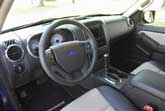
Nuts and Bolts
Nuts and Bolts In the 2007 Ford Explorer Sport Trac, a 210-horsepower V6 and five-speed automatic transmission serve as the base powertrain, while a 292-horsepower V8 and six-speed automatic are optional. Ford offers the 2007 Explorer Sport Trac in two grades – regular and extra strength. The base engine is the familiar 4.0-liter, 12-valve V6 common to the Explorer line. Power equates to 210 horses at 5,100 rpm and 254 lb.-ft. of torque at 3,700 rpm, all managed by a five-speed automatic transmission. That’s decent power for this rig, which weighs in between 4,500 and 4,800 pounds depending on configuration; however, optional for the first time on the Sport Trac is a 4.6-liter, 24-valve V8 good for 292 horsepower at 5,750 rpm and 300 lb.-ft. of twist at 3,700 rpm, all mated to a six-speed automatic transmission. With eight cylinders under the hood, the Explorer pickup will pull up to 6,800 pounds, or about 1,500 pounds more than the V6’s 5,310-lb. rating. Regardless of how buyers outfit a Sport Trac, the independent suspension system will consist of short- and long-arm setups front and rear, complemented by sway bars. Also standard are stability and traction control systems, four-wheel antilock disc brakes with electronic brake-force distribution, and rack-and-pinion steering. XLT models get 16-inch alloy wheels and 235/70 tires, while Limiteds roll on 18s and 235/65 rubber. Four-wheel-drive Sport Tracs use the Control Trac full-time system, with its automatic, high, and low settings. Automatic is for everyday driving, yet pushes some power to the front wheels when things get slippery; high locks the front differential for permanent four-wheel traction; and low is good at maxing out torque for serious grip.
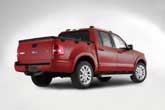
Design
Design Based on the redesigned 2006 Explorer, the 2007 Sport Trac offers an additional four to five inches of wheelbase and length versus the 2005 model, most of it dedicated to rear seat passengers. Like the previous model, the 2007 Ford Sport Trac borrows heavily from the Explorer’s design. From the driver’s seat you’ll notice the dual gauge cluster surrounded by chrome rings, the vertical instrument panel cover, the center console-mounted shift handle, and yes, those same odd, chrome door handles that engineers suggest will be quickly replaced with something a bit more intuitive. A traditional radio, the exact same unit seen in countless other Fords, sits near the top of the dash, and the climate controls sit a few inches below that, with the optional four-wheel-drive related buttons positioned in between. At the bottom of the panel are various controls, such as those for the power-adjustable foot pedals. An armrest with decent storage is situated between the front seats, which are buckets covered in mediocre leather or a dimpled cloth that looks and feels just like the stuff used in a 1985 Ford Tempo. Ah, the down side of retro. Other design highlights include the rubberized flooring – carpet is not available, as Ford claims that Sport Trac buyers want a quick-rinse cabin. Hmm. If you’ve got a video of a Sport Trac buyer hosing out the interior, ever, please send it along – we’d love to see it. On the other hand, maybe the generous use of cheap, hard plastic is due to the chance of occasional precipitation, though water will definitely penetrate the gaps between the panels behind the rear seat, the loose pillar covers, and the flimsy passenger’s side kick panel. Rounding out the interior build-quality issues are inconsistent gaps on the outer edges of the dash, and a rough steel bolt head on the side of the center console. Based on the redesigned 2006 Explorer, the 2007 Sport Trac offers an additional four to five inches of wheelbase and length versus the 2005 model (the Sport Trac skipped the 2006 model year), most of it dedicated to rear seat passengers. The two vehicles look much the same forward of the rear doors, marked by a clean front-end design with a large chrome grille. Behind the cabin is a composite bed that’s wider and deeper for 2007. Three storage wells are incorporated into the floor, two holding up to eight soda cans and the other running the width of the bed. They’re useful, but maybe not as much as the Honda Ridgeline’s large, single cargo hold. Sitting atop the box is an optional, two-piece, hard tonneau cover with locks and a safety release; with weight evenly distributed, 600 pounds of gear can be strapped on top. Finishing off the tail end are simple red and white taillights and a spring-assisted gate that, unfortunately, folds down yet doesn’t open from the side like the Ridgeline. Interestingly, the sheet metal used for the tailgate is the same stamping fitted to an F-150 flareside. As with the interior, the 2007 Ford Explorer Sport Trac’s exterior had its share of quality glitches. On our test truck, the fender flares, attached with adhesive, were separating in a few spots, the gaps around the headlights were notably large, the gaps around the tailgate were uneven, and there were spots where the doors didn’t sit flush with the body.
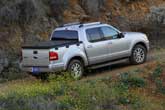
Driving Impressions
Driving Impressions The 2007 Ford Explorer Sport Trac’s V8 pulls nicely and has a pleasant exhaust note, while a good stomp on the pedal will unleash the necessary gusto for spirited stoplight races or sudden highway passes. Much like the Explorer on which it’s based, the 2007 Sport Trac offers a 292-horsepower V8 that allows the truck to move out with authority, though acceleration is hardly breathtaking. Ford executives were shy about giving performance figures, though they did suggest that the extra two cylinders cut about 1.5 seconds off of the standard V6’s 0-60 mph acceleration time. Drivers intent on moving quickly – but not fast – will be reasonably satisfied. In casual driving situations, the V8 pulls nicely and has a pleasant exhaust note, while a good stomp on the pedal will unleash the necessary gusto for spirited stoplight races or sudden highway passes. The five-speed automatic transmission hunts a bit, often settling on a high gear and producing a bogged down feeling. Thankfully, the shifts are seamless, though we’d suggest a manual mode for people interested in the “sport” part of Sport Trac. The same treatment may be due for the soft suspension, which provides a comfy, Lincoln-like ride yet produces lots of body roll in corners as the pliable 18-inch Michelin tires’ sidewalls flex under pressure. On the plus side, the result is a smooth chassis that allows miles of interstate to pass by unnoticed; however, in light of this vehicle’s name, the availability of sport-tuned competitors, and the recent death of the 2007 Sport Trac Adrenalin, an optional performance-tuned suspension setup might be worth investigating. Chances are targeted buyers, 63 percent of whom are mid-30s men in need of a ride for Home Depot runs and weekend kayak trips, would agree. Those folks surely would appreciate the 2007 Sport Trac’s comfortable interior, with spacious and well-cushioned front seats and a roomy rear bench that’s a little too bucketed on the bottom. Grab handles on the B-pillars and passenger A-pillar aid with entry, but the combination of a long rear seat bottom and doors that don’t open wide requires some twisting getting in to the back. Once securely seated, up to five passengers will have fun hitting rock-strewn trails, as a four-wheel-drive Sport Trac is capable of scaling steep, rutted routes without engaging 4-Hi or 4-Lo. Instead, the 4-Auto setting gets the most out of the rear tires and then shifts a bit of power to the front when the terrain gets really gnarly. On our off-road test course, the truck didn’t flinch over some difficult terrain, but skid plates would’ve been nice more than once. For the downhill portion, which was in equal need of a road crew, we opted for 4-Lo and first gear – no worries, and no need for hill descent control, as the low settings kept speeds to a crawl. Shake off the dust and it’s back onto the pavement, where drivers will notice the capable brakes with progressive pedal feel, and a fairly responsive steering system, albeit one that’s not big on communicating road feel. After a day of piloting the redesigned 2007 Ford Explorer Sport Trac V8 more than 150 miles over paved and dirt roads, the trip computer calculated an average fuel economy of 14.3 mpg. Ouch.
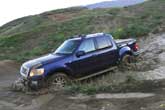
FAQs
FAQs Ford’s 2007 Sport Trac performed very well in crash tests, earning top ratings from the IIHS and NHTSA. How does the 2007 Ford Explorer Sport Trac perform in crash tests? The 2007 Ford Explorer Sport Trac was awarded a Good rating, the best possible, from the Insurance Institute for Highway Safety (IIHS). In National Highway Traffic Safety Administration (NHTSA) testing, the 2007 Ford Explorer Sport Trac received five out of five stars in front and side impact tests. Is the 2007 Ford Explorer Sport Trac’s bed as versatile as the Honda Ridgeline’s? Each has its strengths, so one isn’t necessarily better than the other. In the Honda column, there’s the deep storage well, the large box, and the tailgate that opens from the side or folds down. On the other hand, the Ford offers three storage cubbies (though smaller), multiple exterior tie-down handles, and a locking tonneau cover that will hold up to 600 pounds of rowdy tailgaters. Does the 2007 Ford Explorer Sport Trac compare favorably against a V8-equipped Dodge Dakota Quad Cab? Dodge’s Dakota, the only other midsize truck with an optional V8 (besides its twin, the Mitsubishi Raider), pushes between 230 and 290 horsepower and 290 to 310 lb.-ft. of torque. The 292-horsepower Sport Trac V8 clearly wins the pony war, but with 300 lb.-ft. of torque it lands smack in the middle of the Dakota’s offerings. In more tangible terms, the Dakota can pull 7,050 pounds, whereas the Sport Trac maxes out at 6,800 pounds.
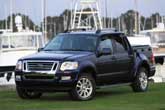
Specifications
Specifications Competitors for the 2007 Ford Explorer Sport Trac include the Chevrolet Colorado Crew Cab, Dodge Dakota Quad Cab, GMC Canyon Crew Cab, Honda Ridgeline, Mitsubishi Raider Double Cab, Nissan Frontier Crew Cab, and Toyota Tacoma Double Cab Test Vehicle: 2007 Ford Explorer Sport Trac Limited V8 4WD Base Price: $30,235 (including a $695 destination charge) Engine Size and Type: 4.6-liter V8 Engine Horsepower: 292 at 5,750 rpm Engine Torque: 300 lb.-ft. at 3,950 rpm Transmission: Six-speed automatic Curb Weight, lbs.: 4,793 EPA Fuel Economy (city/highway): 14/20 mpg Observed Fuel economy: 14.3 mpg Length: 210.2 inches Width: 73.7 inches Wheelbase: 130.5 inches Height: 72.5 inches Legroom (front/rear): 42.4/36.8 inches Headroom (front/rear): 39.8 /38.5 inches Max. Seating Capacity: Five Max. Payload, lbs.: 1,400 Max. Towing Capacity, lbs.: 6,640 Ground Clearance: 8.4 inches Competitors: Chevrolet Avalanche, Chevrolet Colorado Crew Cab, Dodge Dakota Quad Cab, GMC Canyon Crew Cab, Honda Ridgeline, Mitsubishi Raider Double Cab, Nissan Frontier Crew Cab, Toyota Tacoma Double Cab
Photos courtesy of Ford Motor Company
